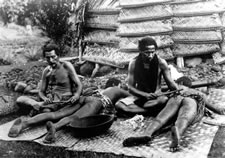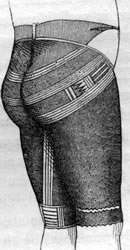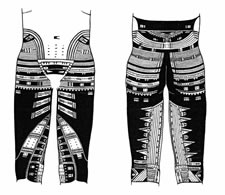Embodied Symbols of the South Seas: Eastern Oceania
Article © 2010 Lars Krutak
Samoa
 |
|
Samoan tufuga at work, ca. 1900. |
Samoa is a major island group skirting the western boundary of Polynesia. Tattooing was highly valued here especially amongst individuals of high rank, and according to traditional Samoan tattoo artist Su'a Sulu'ape Petelo, only chiefs (matai) and their sons and daughters were originally allowed to be tattooed. The overall corpus of designs consisted of a series of bounded zones that were composed within a framework of abstract motifs derived from highly stylized designs taken from nature like millipedes, shells, birds, and the flying fox or fruit bat. Some of these animals were held to be sacred by some families because they embodied ancestral spirits, and when worn as tattoos they enveloped the body in sacred cloak of protection.
According to mythology, the office of tattooing was originally presided over by two twin female patron deities - Tilafainga and Taema - who were also responsible for bringing the art form from Fiji as the following legend relates:
Once there were two sisters who swam from Fiji to Samoa. All the while on their journey they sang songs of the art of tattoo and how it only beautified women in their homeland. They carried with them the tools - the various bone combs and the requisite knowledge. When they neared Samoa they spied an oyster in the depths of the turquoise water and together they dove for it. When they rose to the surface, their songs had become confused: instead of tattoo beautifying women, they chanted that it would beautify men. And so male tattooing came to Samoa.
Another Samoan legend is believed by some writers to be the origin of the pe'a ("flying fox") tattoo design, a motif that is at the very heart of Samoan male tattoo culture. Nafanua, a mythical ancestress of the chiefly house of Tonumaipe'a of Savai'i, was the daughter of the ruler of the underworld and her mother was Tilafainga who brought tattooing to Samoa. She was also the goddess of war. Once, when she was fleeing from a military expedition in Tonga, she became stranded on an inhospitable island. Here she was saved by flying foxes, whom the Tonumaipe'a honored by naming themselves after these revered animals (e.g., Tonumaipe'a translates to "those who are saved by a flying fox"). To this day, the flesh of the flying fox is tapu to everyone except for members of the highest rank. And according to Samoan tattooist Su'a Sulu'ape Petelo, the pe'a itself resembles a flying fox naturalistically hanging from a tree with its wings surrounding its body - the head being the male genitals.
What this symbolism may perhaps reveals is that the pe'a originally stood for protection, since the flying fox also envelopes itself in a natural layer of skin while at rest. Combined with the fact that Nafanua offered her lineage with protective power as the goddess of war, such associations may have given rise to the Samoan concept of wrapping (pulupulu) the human body with a pe'a as a kind of protective shield. A shield that not only embodied mythological and divine power, but also mana.
Tattooing Practitioners and Process
Samoan tattoo artists are called tufuga ta tau (ta tau, "correct, artfully done"), and tattooists with great mana were recognized by the symmetrical designs and finely balanced compositions and linework they executed for their clients. According to contemporary Samoan tattoo masters Su'a Sulu'ape Petelo and Sua Sulu'ape Paulo II, Samoan tattooing was many things to many people. Lines referred to genealogies, adventures, and accomplishments. Curved lines ('aso faaifo) encircled your being, and served as a visual testament to an individual's commitment to permanently incorporate their family's lineage into his or her life. As a rite of initiation, ta tau not only transformed the self into a mature adult, but it also allowed a person to pay homage to their elders while also showing deference to them. In turn, the ta tau serves as an emblem of inspiration for all of those who remain unmarked. |

First published image of Samoan tatau, 1840. |
 Samoan elements of early twentieth-century male tattoo. |
In some districts, the profession of tufuga ta tau was hereditary, but in others it was apparently not. The artist worked with a set of six or more mallets. The handles were typically constructed of bamboo or another light wood, to which were lashed heads of tortoise-shell. These heads were attached to flat combs or rakes (au) of sharpened pig's teeth or human bone that pierced the skin with indelible designs. Tattoo pigment was derived from the lama nut (Aleurites triloba) mixed with water.
Boys and girls were decorated between their fourteenth and eighteenth year. The father built a special shed in which the work was performed and after the tattooing had been completed, the highly tapu structure was burned. The father housed and feasted the tufuga and his assistants with pork, taro, bananas, and fish during the lengthy operation - about two to three months on average - and paid the master in fine mats, waist garments (lavalava), and other articles of local value. The man, if he could afford it, also allowed his son or daughter to invite friends to come and share the skill of the practitioner.
The father's child, for whom the artist was hired, set the pace for the work indicating when, because of pain, the work must stop and the length of the rest periods. Usually the tufuga worked on the client during three periods over the course of a week and continued for as many weeks as was necessary to complete the bold designs.
As noted, tattooists employed assistants. Usually these young men were relatives of the tufuga and they served as apprentices to the master until they displayed the requisite promise and aptitude to become a professional. Part of an assistant's tattoo education included a long and thorough study of traditional designs, ritual chants, as well as extensive practice in wielding the tattooing instruments of his teacher.
Eventually, and if the apprentice proved his ability, he was provided the opportunity of tattooing a client of his master's choosing. If he was successful, he became a candidate for admission into the guild of tufuga ta tau to which his master belonged. Artists who were members of this island-wide organization came from near and far to attend the initiation of the neophyte. If, in the opinion of these professionals, he was qualified to become a tattoo practitioner, he began inking his own clients and developing his personal style. For it is said that those versed in the art can, upon seeing a pattern, name the artist who executed it.
A master normally had up to six assistants ('autufuga). Each one had a particular responsibility, but overlap was certainly encouraged since acquired proficiency in each skill was mandatory for becoming a tattoo master. One apprentice mixed the pigments, another wiped the blood, and another kept the tool black with pigment. One assistant ensured that the ta tau combs remained sharp, another stretched the client's skin, and another uttered chants to instill the necessary courage in the patient so that he would endure the sacred designs of his fellow men and ancestors.
Of course, women could also hold the position of an assistant. Oftentimes they consoled the man who was being tattooed because it was disgraceful and unmanly to show pain during the lengthy ritual. In the case of the son of a chief, several women would pin down the patient and sing the following song to distract him from the violent hammering of the tattooing tool upon the skin:
Friend, stop your wailing and moaning,
that is not the pain of a sick person,
That is the pain of a novice!
Relax your body like giving up,
Give in, o chief!
Soon you will receive your pretty chains of adornment
As yet they are separate and not joined;
The necklace is still in pieces and not quite finished.
Give in, o chief!
But soon in the evening
You will look at your tattoo,
Comparable to a fresh ti leaf.
Give in, o chief!
Ah, if it were a burden
I would carry it for you in my love.
O be quiet and give in,
I will withdraw when the blows have fallen.
Give in, o chief!
The stylet and hammer strike,
The color is applied so that it may adhere.
Give in, o chief!
Like water flows your blood,
Ah, I feel pity for your condition,
Give in, o chief!
But this is the custom ages old,
You constantly moan, but I sing.
Women must bear children,
Man must be tattooed.
And the tattooer will be struck by the trade wind.
Give in, o chief!
The necklace may break, the string may break
But your tattoo will not break.
This necklace of yours is permanent.
And will go into the grave with you.
Give in, o chief!
Ah, you suffer beneath the blows, Ah, till you fall asleep,
And you are not tired nor weary of it!
The process of tattooing began when the small of the back was tattooed with bold designs called tapulu ("to wrap up or cover"). Eventually the buttocks, scrotum, thigh and abdomen were marked. And because so much of the epidermis was covered, the skin became raw and simple bodily movements like walking or reclining were nearly impossible to perform without assistance.
The tattooing ceremony culminated in the piercing of the navel with color. This symbolic act was important, because it consummated the closure of the body and replaced the last physical trace of natural birth. Afterwards, a ceremony called the "sprinkling the of the tattooed" was performed with coconut oil to remove the tapu state of the newly marked and return them to ordinary life.
Next Page | 1
|
2 |
3 |
4 |
5 |
6 |
7 |
8 |
Museum photo gallery of the images
on this page may be seen here. |



